Analysis of Decision Making and Information Systems in Business
VerifiedAdded on 2022/05/17
|6
|1284
|78
Report
AI Summary
This report delves into the multifaceted realm of business decision-making, distinguishing between tactical and operational strategies, and exploring the pivotal role of business intelligence (BI). It provides a comprehensive overview of tactical decisions, such as those concerning workforce composition and sales strategies, and operational decisions, including employee scheduling and equipment purchases. The report then examines BI functionalities, including data mining, reporting, performance metrics, and descriptive analytics, illustrating how these tools aid data-driven choices. Furthermore, it categorizes different types of decisions based on control and performance, offering insights into routine judgments, impact-making, competitive environments, and strategic planning. The report also touches on the application of information systems within organizations, highlighting transaction processing systems (TPS) and their function in managing core business activities.
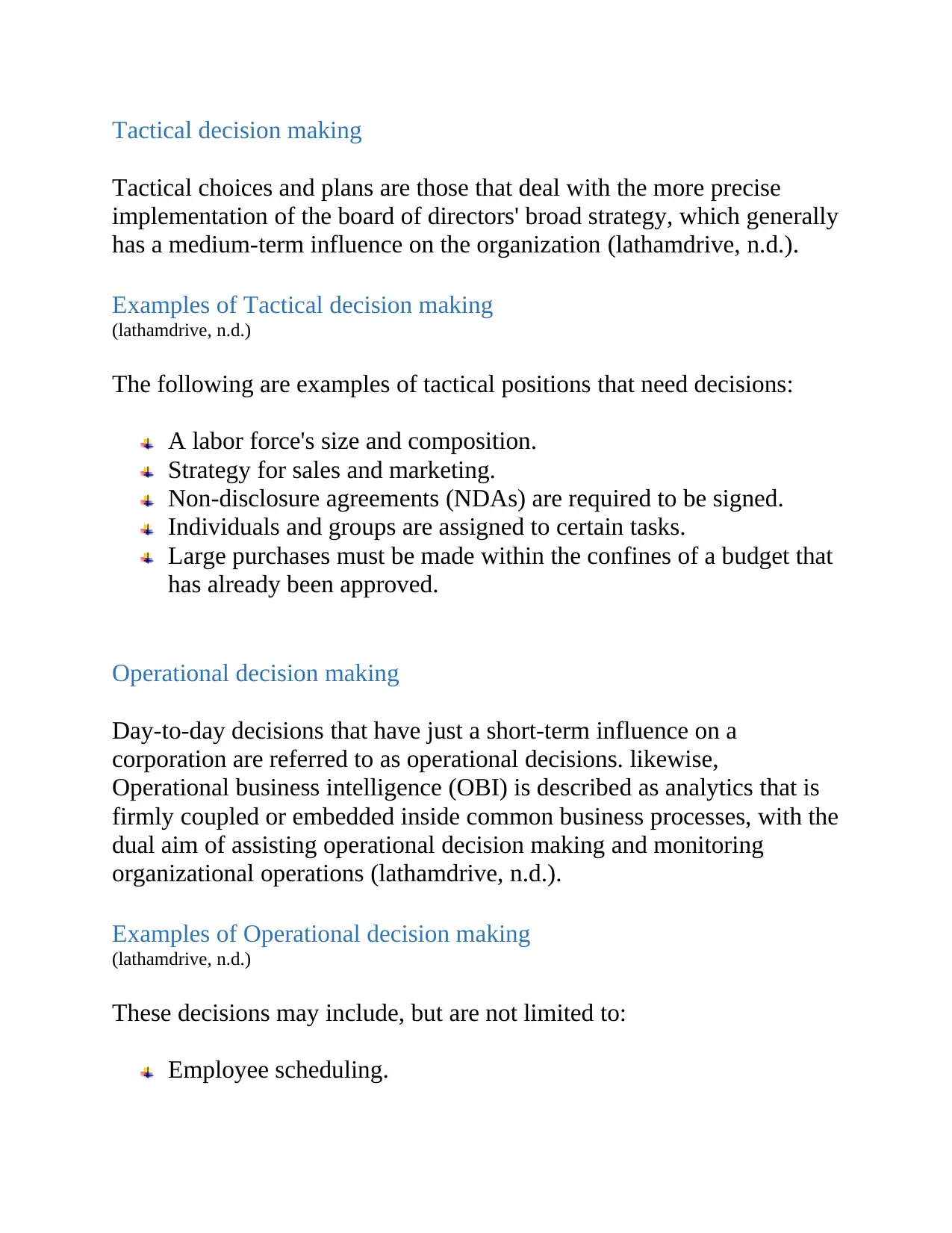
Tactical decision making
Tactical choices and plans are those that deal with the more precise
implementation of the board of directors' broad strategy, which generally
has a medium-term influence on the organization (lathamdrive, n.d.).
Examples of Tactical decision making
(lathamdrive, n.d.)
The following are examples of tactical positions that need decisions:
A labor force's size and composition.
Strategy for sales and marketing.
Non-disclosure agreements (NDAs) are required to be signed.
Individuals and groups are assigned to certain tasks.
Large purchases must be made within the confines of a budget that
has already been approved.
Operational decision making
Day-to-day decisions that have just a short-term influence on a
corporation are referred to as operational decisions. likewise,
Operational business intelligence (OBI) is described as analytics that is
firmly coupled or embedded inside common business processes, with the
dual aim of assisting operational decision making and monitoring
organizational operations (lathamdrive, n.d.).
Examples of Operational decision making
(lathamdrive, n.d.)
These decisions may include, but are not limited to:
Employee scheduling.
Tactical choices and plans are those that deal with the more precise
implementation of the board of directors' broad strategy, which generally
has a medium-term influence on the organization (lathamdrive, n.d.).
Examples of Tactical decision making
(lathamdrive, n.d.)
The following are examples of tactical positions that need decisions:
A labor force's size and composition.
Strategy for sales and marketing.
Non-disclosure agreements (NDAs) are required to be signed.
Individuals and groups are assigned to certain tasks.
Large purchases must be made within the confines of a budget that
has already been approved.
Operational decision making
Day-to-day decisions that have just a short-term influence on a
corporation are referred to as operational decisions. likewise,
Operational business intelligence (OBI) is described as analytics that is
firmly coupled or embedded inside common business processes, with the
dual aim of assisting operational decision making and monitoring
organizational operations (lathamdrive, n.d.).
Examples of Operational decision making
(lathamdrive, n.d.)
These decisions may include, but are not limited to:
Employee scheduling.
Paraphrase This Document
Need a fresh take? Get an instant paraphrase of this document with our AI Paraphraser
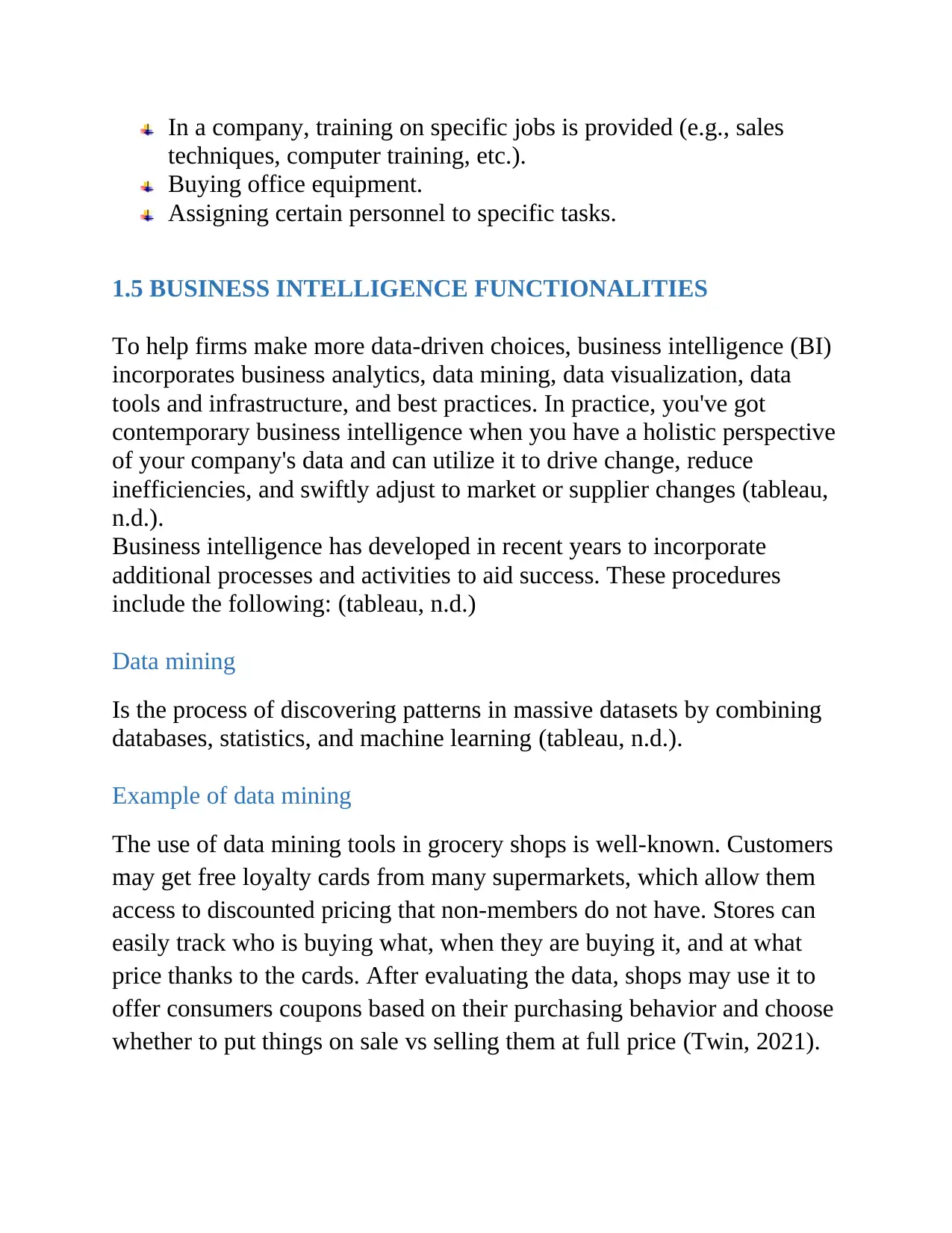
In a company, training on specific jobs is provided (e.g., sales
techniques, computer training, etc.).
Buying office equipment.
Assigning certain personnel to specific tasks.
1.5 BUSINESS INTELLIGENCE FUNCTIONALITIES
To help firms make more data-driven choices, business intelligence (BI)
incorporates business analytics, data mining, data visualization, data
tools and infrastructure, and best practices. In practice, you've got
contemporary business intelligence when you have a holistic perspective
of your company's data and can utilize it to drive change, reduce
inefficiencies, and swiftly adjust to market or supplier changes (tableau,
n.d.).
Business intelligence has developed in recent years to incorporate
additional processes and activities to aid success. These procedures
include the following: (tableau, n.d.)
Data mining
Is the process of discovering patterns in massive datasets by combining
databases, statistics, and machine learning (tableau, n.d.).
Example of data mining
The use of data mining tools in grocery shops is well-known. Customers
may get free loyalty cards from many supermarkets, which allow them
access to discounted pricing that non-members do not have. Stores can
easily track who is buying what, when they are buying it, and at what
price thanks to the cards. After evaluating the data, shops may use it to
offer consumers coupons based on their purchasing behavior and choose
whether to put things on sale vs selling them at full price (Twin, 2021).
techniques, computer training, etc.).
Buying office equipment.
Assigning certain personnel to specific tasks.
1.5 BUSINESS INTELLIGENCE FUNCTIONALITIES
To help firms make more data-driven choices, business intelligence (BI)
incorporates business analytics, data mining, data visualization, data
tools and infrastructure, and best practices. In practice, you've got
contemporary business intelligence when you have a holistic perspective
of your company's data and can utilize it to drive change, reduce
inefficiencies, and swiftly adjust to market or supplier changes (tableau,
n.d.).
Business intelligence has developed in recent years to incorporate
additional processes and activities to aid success. These procedures
include the following: (tableau, n.d.)
Data mining
Is the process of discovering patterns in massive datasets by combining
databases, statistics, and machine learning (tableau, n.d.).
Example of data mining
The use of data mining tools in grocery shops is well-known. Customers
may get free loyalty cards from many supermarkets, which allow them
access to discounted pricing that non-members do not have. Stores can
easily track who is buying what, when they are buying it, and at what
price thanks to the cards. After evaluating the data, shops may use it to
offer consumers coupons based on their purchasing behavior and choose
whether to put things on sale vs selling them at full price (Twin, 2021).
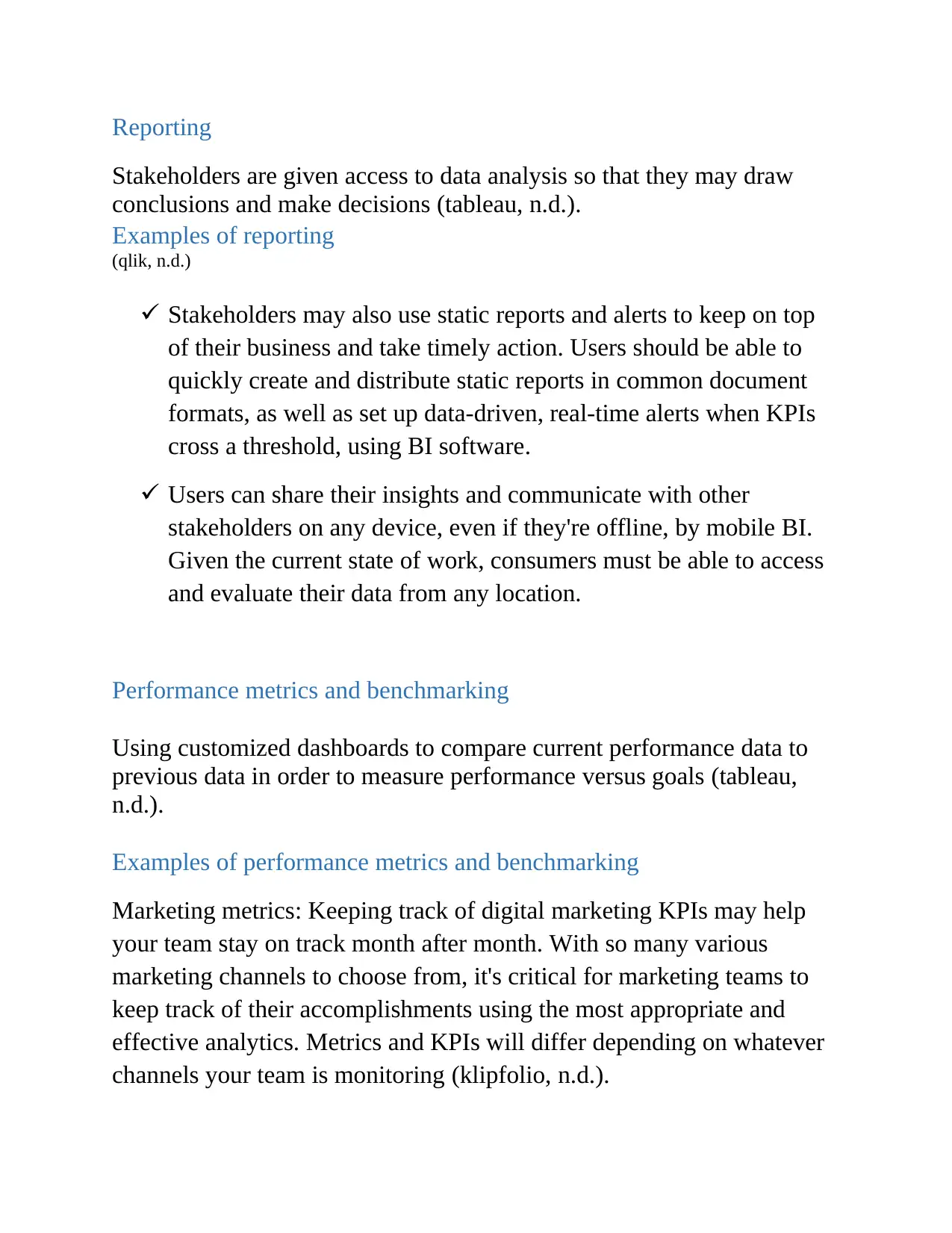
Reporting
Stakeholders are given access to data analysis so that they may draw
conclusions and make decisions (tableau, n.d.).
Examples of reporting
(qlik, n.d.)
Stakeholders may also use static reports and alerts to keep on top
of their business and take timely action. Users should be able to
quickly create and distribute static reports in common document
formats, as well as set up data-driven, real-time alerts when KPIs
cross a threshold, using BI software.
Users can share their insights and communicate with other
stakeholders on any device, even if they're offline, by mobile BI.
Given the current state of work, consumers must be able to access
and evaluate their data from any location.
Performance metrics and benchmarking
Using customized dashboards to compare current performance data to
previous data in order to measure performance versus goals (tableau,
n.d.).
Examples of performance metrics and benchmarking
Marketing metrics: Keeping track of digital marketing KPIs may help
your team stay on track month after month. With so many various
marketing channels to choose from, it's critical for marketing teams to
keep track of their accomplishments using the most appropriate and
effective analytics. Metrics and KPIs will differ depending on whatever
channels your team is monitoring (klipfolio, n.d.).
Stakeholders are given access to data analysis so that they may draw
conclusions and make decisions (tableau, n.d.).
Examples of reporting
(qlik, n.d.)
Stakeholders may also use static reports and alerts to keep on top
of their business and take timely action. Users should be able to
quickly create and distribute static reports in common document
formats, as well as set up data-driven, real-time alerts when KPIs
cross a threshold, using BI software.
Users can share their insights and communicate with other
stakeholders on any device, even if they're offline, by mobile BI.
Given the current state of work, consumers must be able to access
and evaluate their data from any location.
Performance metrics and benchmarking
Using customized dashboards to compare current performance data to
previous data in order to measure performance versus goals (tableau,
n.d.).
Examples of performance metrics and benchmarking
Marketing metrics: Keeping track of digital marketing KPIs may help
your team stay on track month after month. With so many various
marketing channels to choose from, it's critical for marketing teams to
keep track of their accomplishments using the most appropriate and
effective analytics. Metrics and KPIs will differ depending on whatever
channels your team is monitoring (klipfolio, n.d.).
⊘ This is a preview!⊘
Do you want full access?
Subscribe today to unlock all pages.

Trusted by 1+ million students worldwide
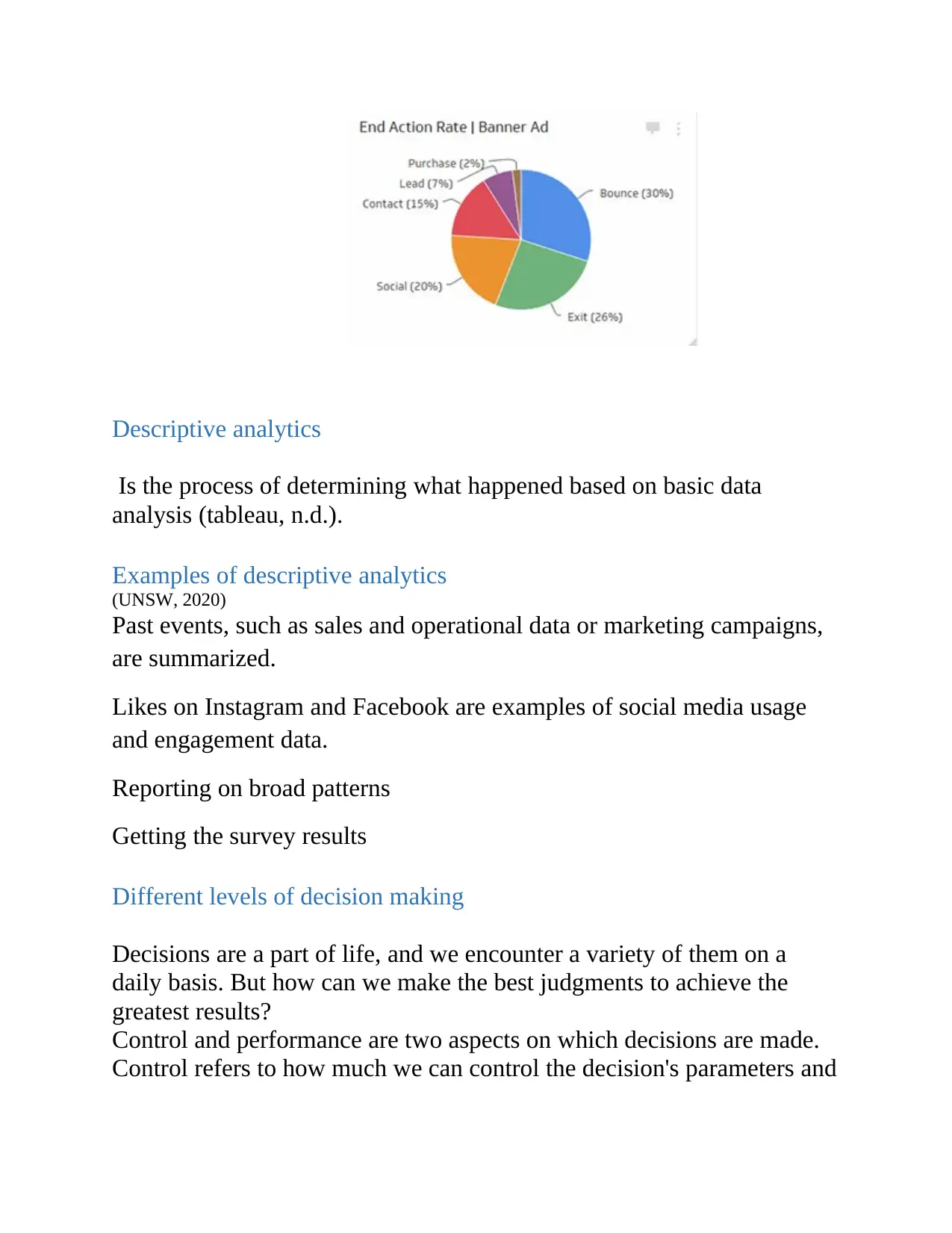
Descriptive analytics
Is the process of determining what happened based on basic data
analysis (tableau, n.d.).
Examples of descriptive analytics
(UNSW, 2020)
Past events, such as sales and operational data or marketing campaigns,
are summarized.
Likes on Instagram and Facebook are examples of social media usage
and engagement data.
Reporting on broad patterns
Getting the survey results
Different levels of decision making
Decisions are a part of life, and we encounter a variety of them on a
daily basis. But how can we make the best judgments to achieve the
greatest results?
Control and performance are two aspects on which decisions are made.
Control refers to how much we can control the decision's parameters and
Is the process of determining what happened based on basic data
analysis (tableau, n.d.).
Examples of descriptive analytics
(UNSW, 2020)
Past events, such as sales and operational data or marketing campaigns,
are summarized.
Likes on Instagram and Facebook are examples of social media usage
and engagement data.
Reporting on broad patterns
Getting the survey results
Different levels of decision making
Decisions are a part of life, and we encounter a variety of them on a
daily basis. But how can we make the best judgments to achieve the
greatest results?
Control and performance are two aspects on which decisions are made.
Control refers to how much we can control the decision's parameters and
Paraphrase This Document
Need a fresh take? Get an instant paraphrase of this document with our AI Paraphraser
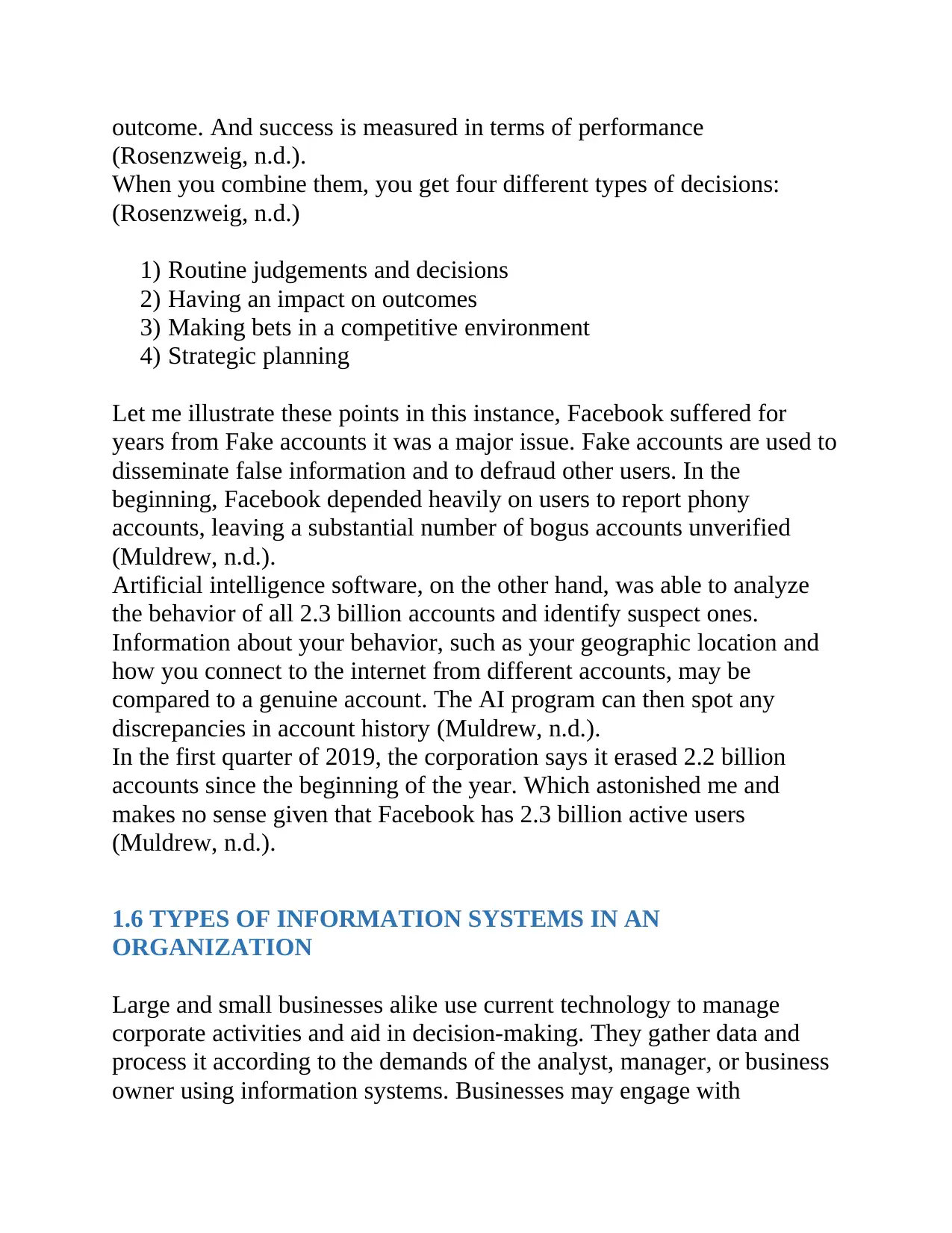
outcome. And success is measured in terms of performance
(Rosenzweig, n.d.).
When you combine them, you get four different types of decisions:
(Rosenzweig, n.d.)
1) Routine judgements and decisions
2) Having an impact on outcomes
3) Making bets in a competitive environment
4) Strategic planning
Let me illustrate these points in this instance, Facebook suffered for
years from Fake accounts it was a major issue. Fake accounts are used to
disseminate false information and to defraud other users. In the
beginning, Facebook depended heavily on users to report phony
accounts, leaving a substantial number of bogus accounts unverified
(Muldrew, n.d.).
Artificial intelligence software, on the other hand, was able to analyze
the behavior of all 2.3 billion accounts and identify suspect ones.
Information about your behavior, such as your geographic location and
how you connect to the internet from different accounts, may be
compared to a genuine account. The AI program can then spot any
discrepancies in account history (Muldrew, n.d.).
In the first quarter of 2019, the corporation says it erased 2.2 billion
accounts since the beginning of the year. Which astonished me and
makes no sense given that Facebook has 2.3 billion active users
(Muldrew, n.d.).
1.6 TYPES OF INFORMATION SYSTEMS IN AN
ORGANIZATION
Large and small businesses alike use current technology to manage
corporate activities and aid in decision-making. They gather data and
process it according to the demands of the analyst, manager, or business
owner using information systems. Businesses may engage with
(Rosenzweig, n.d.).
When you combine them, you get four different types of decisions:
(Rosenzweig, n.d.)
1) Routine judgements and decisions
2) Having an impact on outcomes
3) Making bets in a competitive environment
4) Strategic planning
Let me illustrate these points in this instance, Facebook suffered for
years from Fake accounts it was a major issue. Fake accounts are used to
disseminate false information and to defraud other users. In the
beginning, Facebook depended heavily on users to report phony
accounts, leaving a substantial number of bogus accounts unverified
(Muldrew, n.d.).
Artificial intelligence software, on the other hand, was able to analyze
the behavior of all 2.3 billion accounts and identify suspect ones.
Information about your behavior, such as your geographic location and
how you connect to the internet from different accounts, may be
compared to a genuine account. The AI program can then spot any
discrepancies in account history (Muldrew, n.d.).
In the first quarter of 2019, the corporation says it erased 2.2 billion
accounts since the beginning of the year. Which astonished me and
makes no sense given that Facebook has 2.3 billion active users
(Muldrew, n.d.).
1.6 TYPES OF INFORMATION SYSTEMS IN AN
ORGANIZATION
Large and small businesses alike use current technology to manage
corporate activities and aid in decision-making. They gather data and
process it according to the demands of the analyst, manager, or business
owner using information systems. Businesses may engage with
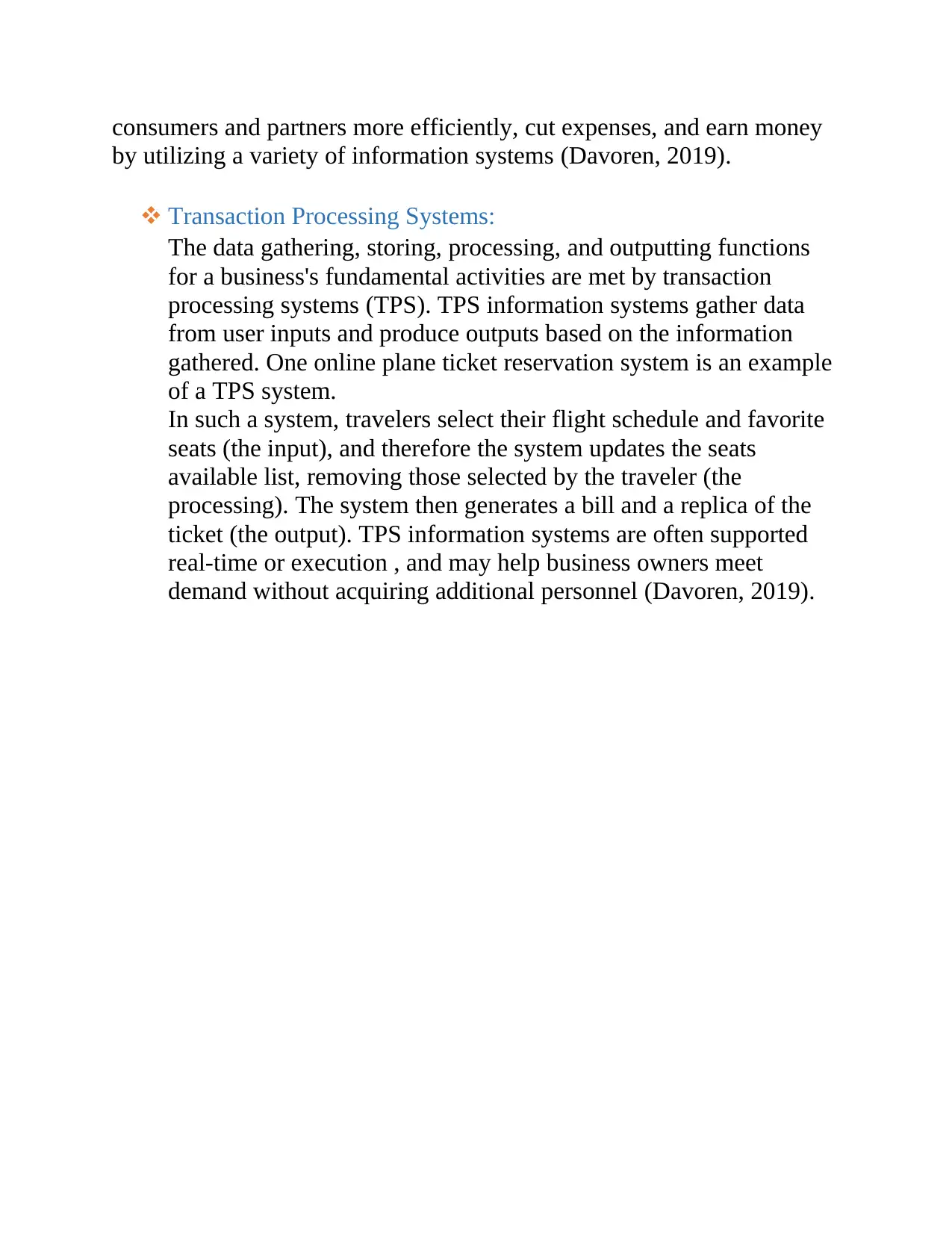
consumers and partners more efficiently, cut expenses, and earn money
by utilizing a variety of information systems (Davoren, 2019).
Transaction Processing Systems:
The data gathering, storing, processing, and outputting functions
for a business's fundamental activities are met by transaction
processing systems (TPS). TPS information systems gather data
from user inputs and produce outputs based on the information
gathered. One online plane ticket reservation system is an example
of a TPS system.
In such a system, travelers select their flight schedule and favorite
seats (the input), and therefore the system updates the seats
available list, removing those selected by the traveler (the
processing). The system then generates a bill and a replica of the
ticket (the output). TPS information systems are often supported
real-time or execution , and may help business owners meet
demand without acquiring additional personnel (Davoren, 2019).
by utilizing a variety of information systems (Davoren, 2019).
Transaction Processing Systems:
The data gathering, storing, processing, and outputting functions
for a business's fundamental activities are met by transaction
processing systems (TPS). TPS information systems gather data
from user inputs and produce outputs based on the information
gathered. One online plane ticket reservation system is an example
of a TPS system.
In such a system, travelers select their flight schedule and favorite
seats (the input), and therefore the system updates the seats
available list, removing those selected by the traveler (the
processing). The system then generates a bill and a replica of the
ticket (the output). TPS information systems are often supported
real-time or execution , and may help business owners meet
demand without acquiring additional personnel (Davoren, 2019).
⊘ This is a preview!⊘
Do you want full access?
Subscribe today to unlock all pages.

Trusted by 1+ million students worldwide
1 out of 6
Related Documents
Your All-in-One AI-Powered Toolkit for Academic Success.
+13062052269
info@desklib.com
Available 24*7 on WhatsApp / Email
![[object Object]](/_next/static/media/star-bottom.7253800d.svg)
Unlock your academic potential
Copyright © 2020–2025 A2Z Services. All Rights Reserved. Developed and managed by ZUCOL.





